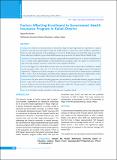Please use this identifier to cite or link to this item:
https://hdl.handle.net/20.500.14356/1418| Title: | Factors Affecting Enrollment in Government Health Insurance Program in Kailali District |
| Authors: | Paudel, Deepak Raj |
| Citation: | PaudelD. R. (2019). Factors Affecting Enrollment in Government Health Insurance Program in Kailali District. Journal of Nepal Health Research Council, 17(3), 388-393. https://doi.org/10.33314/jnhrc.v17i3.2026 |
| Issue Date: | 2019 |
| Publisher: | Nepal Health Research Council |
| Article Type: | Original Article |
| Keywords: | Enrollment Health expenditure Inequality Nepal |
| Series/Report no.: | July-Sep, 2019;2026 |
| Abstract: | Abstract Background: Health care financial burden on households is high in Nepal. High health care expenditure is a major obstacle in achieving universal health coverage. The health insurance is expected to reduce healthcare expenditure. However, only small segments of the population are covered by health insurance in Nepal.This study assessed the factors affecting enrollment in government health insurance program in the first piloted district, Kailali, Nepal. Methods: A cross-sectional survey was conducted among 1048 households located in 26 wards of Kailali district after 21 months of the implementation of social health insurance program, Nepal. The sample was selected in two stages, first stage being the selection of wards and second, being the households. Results: The higher level of household economic status was associated with increased odds of enrollment in health insurance program (ORs=4.99, 5.04, 5.13, 8.05, for second, third, fourth, and the highest quintile of households, respectively). A higher level of head’s education was associated with increased odds of health insurance enrollment (ORs = 1.58, 1.78, 2.36, for primary, secondary, tertiary education, respectively). Presence of chronic illness in the household was positively associated with increased odds of health insurance enrollment (OR= 1.29). Conclusions: The poor and low educated groups were less benefited by social health insurance program in Kailali district, Nepal. Hence, policymakers should focus to implement income-based premium scheme for ensuring equal access to healthcare.Since household with chronic illness leads to high odds of being enrolled, a compulsory health insurance scheme can make the program financially sustainable. Keywords: Enrollment; health expenditure; health insurance; inequality; Nepal. |
| Description: | Original Article |
| URI: | http://103.69.126.140:8080/handle/20.500.14356/1418 |
| ISSN: | Print ISSN: 1727-5482; Online ISSN: 1999-6217 |
| Appears in Collections: | Vol. 17 No. 3 Issue 44 Jul-Sep 2019 |
Files in This Item:
| File | Description | Size | Format | |
|---|---|---|---|---|
| 2026-Manuscript-12215-1-10-20191114.pdf | Fulltext Download | 261.11 kB | Adobe PDF |  View/Open |
Items in DSpace are protected by copyright, with all rights reserved, unless otherwise indicated.
